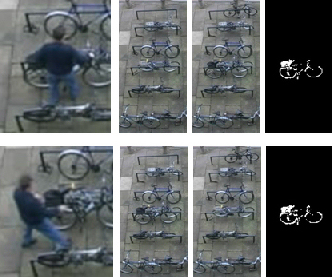Associating Drop and Pick Events in the Bicycles DomainDima Damen, David HoggThis research aims at recognising drop and pick events in cluttered environments, as well as connecting drops with picks of the same object. This helps in providing an automatic log of events occurring. It can also be utilized in security applications like theft detection. Due to visual ambiguities arising from occlusion and noise, we find the best constrained globally optimal explanation given all data up-to-date. The approach is being evaluated on a several-days datasets from CCTV cameras.
Research MotivationSeveral local councils had been installing CCTV cameras on top of bicycles racks to deter bicycle thefts. In June 2007, York had announced such a scheme after they noticed an alarming increase in bicycle thefts (The press). Yet installing CCTV cameras that are manually monitored has not proven as efficient as required in London (Daily Mail). A solution is thus sought to minimize the monitoring time and highlight cases where thefts are suspected.
Media CoverageFeb 2008: Bike chains get high-tech backup Briefing Latest, Engineering and TechnologyMar 2008: Safer cycles insight - The business magazine of the University of Leeds Feb 2008: Silicon essentials - Bicycle Theft Detection HERO Dec 21st 2007: Student's camera technology will help combat bicycle thefts. Yorkshire Post Dec 20th 2007: Putting the breaks on bicycle thieves. Press Release by the University of Leeds PR office The Method
(b) The match between pixels is used to connect drop to pick events (c) A constrained globally optimal solution is seeked for all observations available until now AcknowledgementNational Express East Anglia kindly assisted in the research by providing a dataset from one of their CCTV cameras overlooking a cluttered bicycle rack in a train station. |




